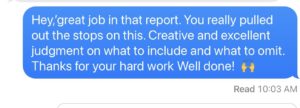This article is part of a series on gratitude at work. The ideas shared are relevant for leaders, aspiring leaders, and anyone interested in generosity and humanity at work. See links to other articles in the series at the end of this post (and at the blog).
Is it better to express thanks to someone in person, in video, or text? Many people may have a belief that thanking someone in-person is ideally the best way. However, with the past two years being predominantly a virtual work world, this question has recently attracted some interest with some research and an interesting twist.
I’ll get to the research in a bit, but first let me ask YOU: What’s your preference for giving thanks in the work context? Do you prefer in person, on video, or some form of text/written? What about receiving thanks?
Personally, from my perspective (half price today:) I think receiving any words of appreciation and thanks is simply awesome, whether it’s live or sent via email or text. It’s all good! But I must share that receiving a thank you in writing has some extra benefits, kind of an extended boost of ‘awesome’.
Here’s why: I can read the awesome words of appreciation again and again.
Our brains are hardwired with a bias to hold on more tightly to negative experiences and emotions, and more loosely to positive ones. But neuroscience teaches us that the positive emotions broaden our minds and our potential to think better, perform better, relate better — and to generally spiral up in our work and lives.
Negativity, contracts our thinking, and our potential. So when the tough stuff comes, we can easily lose sight of a positive experienced (like receiving a verbal thank you). A written and meaningful thank you with acknowledgment of appreciation can have a more lasting impact. And one can read it over again.
By the way, the tactic of revisiting positive moments (i.e. re-reading a thank you note) is frequently referred to as a ‘savoring’ strategy in the world of positive psychology. E.g. to recall positive memories, look at photos (vacays, happy experiences), and to look forward to positive experience. You can read more about ‘savoring’ in this brief article here.
How about the good feelings that come with giving thanks?
Well, like many others, I enjoy expressing gratitude — so much so that, in fact, it is one of my top Signature Character Strengths.
I’m not alone. Here’s a true story.
Last January, I began coaching a senior-level leader who was feeling some blahs and wear and tear (like many others in the pandemic). We began our work exploring how she can get her spark back even though the road ahead in the pandemic was still long, socially distanced (lonely), and uncertain. She was also concerned about her people (team) losing their spark.
She told me that not only did she miss the in-office banter and social connections, she was frustrated at the loss of one of her favorite rituals. Each week she would make sure to stop in to connect with people from her team (individually) and give them a meaningful ‘high five’ with words of appreciation for their work and effort that week. She felt good about making other people feel appreciated (and they felt good too!). It was mojo-boosting for her and the receiver (not surprising gratitude was also one of her top Signature Strengths).
(So why stop doing that just because you can’t do this in person? One of my pandemic resilience messages this year has been to encourage people not to forego their essential needs that fuel their wellbeing (mental, physical, emotional). But instead, recalibrate and find new ways to do them.)
So together we explored how to recalibrate her feel-good ritual of giving thanks to her people. . She came up with the idea of allocating time at the end of each week to write personal letters (emails) of appreciation for at least a few people each week. A couple of weeks later, she shared this new way of saying thanks was well in play and she felt so much better for it, as did those on the receiving end.
Which brings us back to the research….does it really have to be in person?
The Greater Good newsletter, shared research (previously published in the Journal of Positive Psychology) that compared the effects of expressing thanks in person, over a video call, and over text. Despite the common-held belief that an in-person thank-you would be most meaningful, it turns out that sending a thank-you via text was almost as impactful as delivering the message in person.
What was most interesting was that this research explicitly looked at the benefits to the giver of thanks and less so on the receiver. Since gratitude (one of the most studied and researched character strengths), is known to boost the wellbeing of the giver, this lens made sense. A second study seemed to support that there was not as much difference for the receiver either.
This is good news for those who feel awkward expressing gratitude in person!
Not everyone feels comfortable expressing appreciation. Some people are shy and feel awkward so they make a big deal in their minds about how to do it perfectly: when, where, and how to say thank you and express appreciation. They end up procrastinating, or not doing it at all. And then they feel kinda bad about it (negative spiral).
So the research here offers an important message: Don’t sweat it! Just do it!
Write that note! Send that letter. And feel good knowing that the recipient can enjoy it over and over again at their leisure.
Morale of the Story:
Saying thanks is much more powerful than not saying thanks (for the giver and the receiver). The modality might matter but not as much as you think. If you can’t meet in person then video is an option. And writing a genuine, thoughtful note of appreciation can be truly awesome as well. One thing for sure: It will be way better than not doing it at all.
Remember: these ideas work for anyone in any level — not only leaders in a formal position.
Here are Links to the Other Articles in the Series:
- Expressing Thanks at Work: Good for You and Others.
- Three Ways to Say Thanks at Work — Better and More Meaningfully
Please share this story if you think others would enjoy it!
Eileen Chadnick, PCC, ACPC of Big Cheese Coaching, is an ICF credentialed executive coach, team coach, workshop facilitator, and writer specializing in career navigation, executive and leadership development, culture-building, and communications. Principal of Big Cheese Coaching and Chadnick Communications in Toronto, Eileen draws from the disciplines of positivity, emotional intelligence – and Conversational Intelligence®(C‐IQ®) in her work. She is author of the book, Ease: Manage Overwhelm in Times of Crazy Busy. See more at www.bigcheesecoaching.com



0 Comments